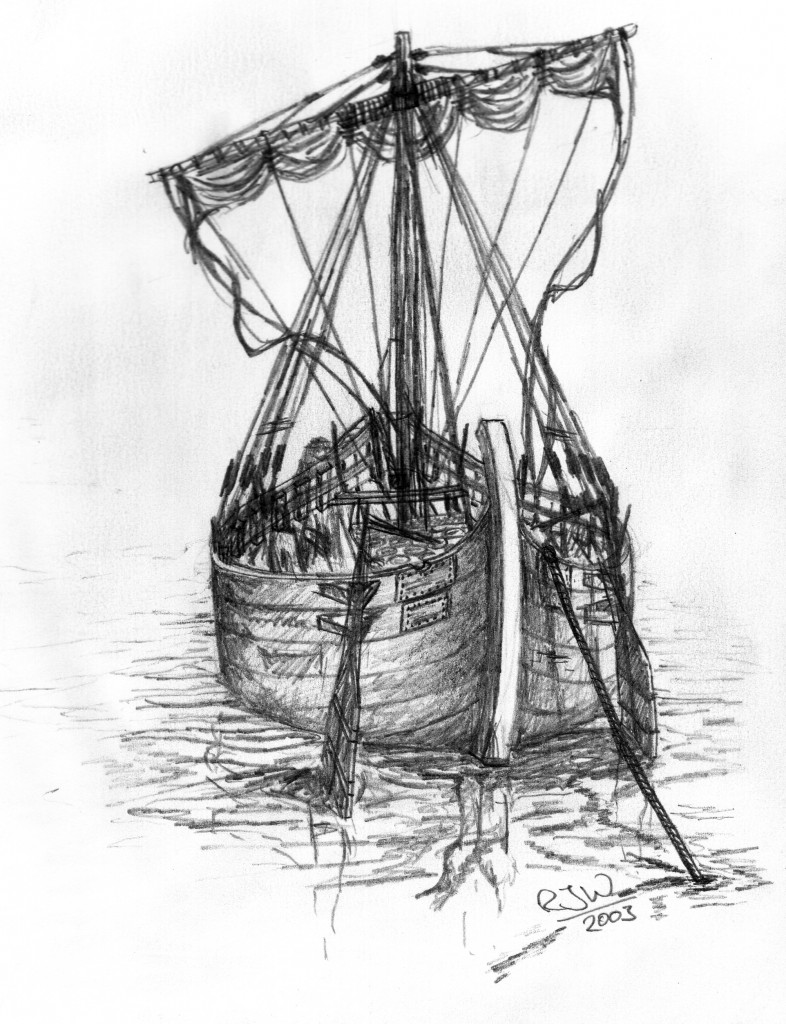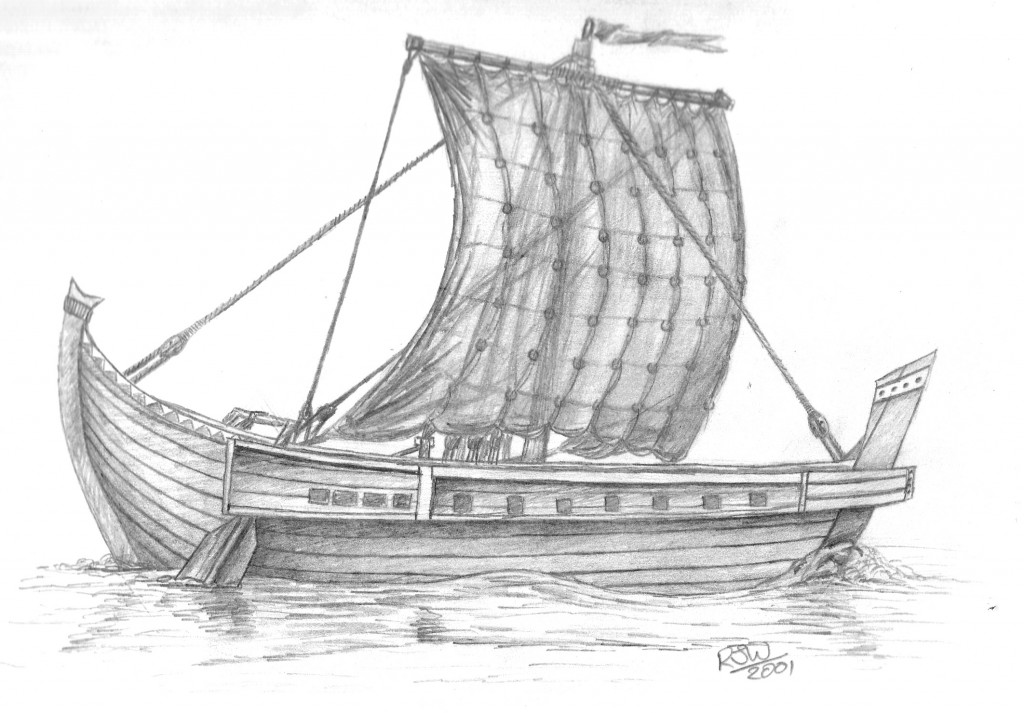Roman Mediterranean Shipping

Some of the learners on the course have requested more information about the types of ships in the Roman Mediterranean. The diverse ships and boats at Portus itself would have ranged from giant long-distance merchant ships, through vessels engaged in coastal trade, to small fishing boats capable of travelling only a few miles. In addition, there would have been many different types of vessel present, dedicated to the service of the port itself. Barges and lighters would have been used for moving cargoes from the ships to the quays, or on up the canals and river to Rome. Meanwhile, tugboats powered by teams of rowers provided a service pulling vessels in and out of the harbour basins and dredging vessels would have kept the harbour free from silt, allowing the largest vessels to use the port.
Vessels anchored alongside a quay are shown in reliefs and mosaics from Ostia and Portus, with a gangplank running from the bow to the shore to allow teams of stevedores to unload the cargo. For those vessels moored away from the quays in the harbour basins, everything would have to be unloaded into small vessels known as lighters, carried to the shore and then unloaded again. Both these kinds of operation would have been very time-consuming and required a lot of organisation to ensure that everything ran smoothly.
In terms of the Roman ships themselves, we know from archaeological discoveries at Portus, Ostia and elsewhere across the Mediterranean, that most of them were built in a similar way. The builders constructed the outer planking of the vessel first; each plank joined to the one above with hundreds of mortise-and-tenon joints, locked in place with small pegs. A framework to provide additional reinforcement was then added to the inside of the vessel. Although it was time-consuming to build ships and boats in this way, it resulted in very strong, durable vessel and this construction method was used in the Mediterranean for many centuries.
Roman ships built in the mortise-and-tenon tradition could reach huge sizes. The largest excavated comes from the site of Madrague de Giens in the south of France, was over 40m in length and could have carried a cargo of around 400 tons. On its last voyage in the 1st c BC it had 7-10,000 Italian wine amphorae on board, destined for southern Gaul. The average Roman ship was far smaller, perhaps around 15-20 metres and capable of carrying 75 tons of cargo. Finally, the one of the fishing boats excavated at Portus, was only a few metres in length; (see the Navis website at http://www2.rgzm.de/navis/home/frames.htm)

Although the method of construction was similar across the Roman Mediterranean, the shapes of the hulls were not. Some vessels were quite flat-bottomed so that they could work in shallow water and up and down rivers, canals and estuaries. Meanwhile, other vessels had very deep keels, shaped like a wine glass that allowed them to sail more effectively. Many vessels carried a birds head on the stern of the vessel and some ships had an underwater projection at the bow, like the bow of a modern tanker, to cut through the water more efficiently.
All of the ships of the Roman Mediterranean were powered by rowing or by sailing, as can be seen from many mosaics and carved reliefs. Remains of the sails themselves are very rare in the archaeological record, most of the known finds come from the Roman Ports on the Egyptian Red Sea coast. But the mosaics and reliefs show us that the majority of vessels were rigged with a square sail, usually a single large sail, or sometimes two square sails on two masts. Some smaller vessels, such as the tugboats and harbour boats found at Portus used a different type of sail called a sprit-sail, that was better for working in the more confined spaces of the harbour basins.
The rigging used on the Mediterranean square-sail is unique to this period in history. It consisted of many small rings, made from wood, lead or horn, that were sewn onto the face of the sail. These rings, called brail rings, guided a series of lines that could be hauled on from the deck in order to change the shape of the sail, reduce the size of it in stronger wind and to furl the sail when needed. Unlike on vessels in later periods, no crew needed to climb the rigging to trim or take in the sails.
Sailing ships in the Roman period did not need a large crew. The square-sail that was used by the majority of vessels was efficient to use and archaeological remains, along with experimental archaeology, tell us that a crew of four or five people could operate a ship with a single-mast of about 150 tons. Sailing vessels were therefore the most favoured for carrying cargo because they were much cheaper to operate. Warships were usually powered by oars which meant that they were not reliant on the wind. But their large crews were expensive to maintain and their need for food and water meant that the range of warships was limited.
The Mediterranean square-sail allowed vessels to sail at a steady speed day and night. In good weather, with a favourable wind from the side or behind, a vessel could reach average speeds of between four and six knots. If the wind was blowing in the wrong direction progress was very slow and only the most well-maintained vessels with the best crews were able to sail against the wind at an angle of no more than sixty or seventy degrees. Literary sources suggest that most sailors preferred to wait in port for better weather.
Navigation in the ancient world was based on careful observation of the environment; the sun, stars and weather conditions. By doing this, and drawing upon many centuries of learned knowledge, sailors could navigate their way comfortably around the Mediterranean. They could sail on courses that took them out of sight of land and they were able to sail through the night, finding their way by the stars. The most common piece of equipment was a lead sounding weight. This allowed the depth of the water to be established, but it also recovered a sample of the seabed and an experienced navigator could use this extra information to help maintain a course or sense when land was approaching, but still out of sight.
The strong hull construction and effective, flexible sailing rigs meant that Roman ships could sail the whole length of the Mediterranean if required. There are literary records of voyages from Alexandria to Marseilles and in the Indian Ocean, Roman ships could sail directly from Africa to India across the open sea. Because of this, the Mediterranean Sea acted as major means of travel and communication, as well as for connecting trade routes, to the land around the sea. Ships could sail straight from one place to another, or they might go from port to port along the coast, picking up new cargo and unloading old cargoes as they went.
It is estimated that in the Roman period, the Mediterranean was better connected than at any point until the 19th century. The ships, boats, method of construction and the sailing rigs used were partly responsible for making this possible, but the biggest contribution came from the maritime skills and seamanship of Roman sailors and navigators.
You might want to look back at The links to other ports.



